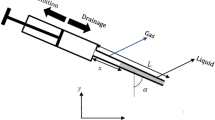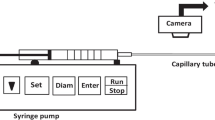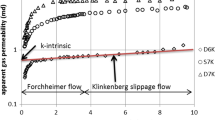Abstract
This article presents an investigation into the effects of pneumatic pressure of trapped air on the dynamics of capillary filling. Controlled experiments were carried out in horizontal closed-end capillaries with diameters of 200–700 μm. Glycerol–DI water mixture solutions having viscosities ranging from 8 to 80 mPa s were used as the filling liquids. The pneumatic air backpressure is built up as a result of the air compressed at the closed end of the capillary. A model is presented based on the conventional theory of capillary filling (i.e., Washburn’s equation) with consideration of the effect of air backpressure force on the advancing meniscus. The molecular kinetics theory of Blake and De Coninck’s model (Adv Colloid Interface Sci 96:21–36, 2002) is also incorporated in the model to account for the dependence of dynamic contact angle on wetting velocity. The model predictions agree reasonably well with the experimental data. It is observed that due to the presence of air backpressure, the smaller the capillary diameter, the longer the length that the liquid fills the capillary, regardless of the liquid viscosity. It is also shown that the increased pneumatic air backpressure reduces the equilibrium contact angle (θ 0). A relation is then proposed among liquid penetration, capillary length and radius, and contact angle. In addition, a dimensionless analysis is performed on experimental data, and the power law dependence of dimensionless meniscus position on dimensionless time is obtained.










Similar content being viewed by others
Abbreviations
- AV:
-
Attached volume (m3)
- D :
-
Capillary diameter (m)
- g :
-
Gravitational acceleration (m/s2)
- \( g_{\text{W}}^{*} \) :
-
Specific activation free energy of wetting (J/m2)
- h :
-
Planck constant (J s)
- H :
-
Liquid column height (m)
- \( K_{\text{W}}^{0} \) :
-
Equilibrium frequency of displacement of a liquid molecule between adjacent adsorption sites on solid surface (s−1)
- k B :
-
Boltzmann constant (J/K)
- L :
-
Effective total length of the capillary tube (m)
- n :
-
Number of adsorption sites per unit area of solid surface (m−2)
- P air :
-
Air backpressure (Pa)
- P air at equilibrium :
-
Equilibrium air backpressure (Pa)
- P atm :
-
Ambient pressure (Pa)
- P C :
-
Capillary pressure (Pa)
- R :
-
Radius of curvature at liquid–air interface (m)
- r :
-
Capillary radius (m)
- T :
-
Absolute temperature (K)
- t :
-
Time (s)
- x :
-
Meniscus position (m)
- \( \dot{x} \) :
-
Meniscus velocity (m/s)
- \( \ddot{x} \) :
-
Meniscus acceleration (m/s2)
- \( Ca = {{\eta \dot{x}} \mathord{\left/ {\vphantom {{\eta \dot{x}} \gamma }} \right. \kern-\nulldelimiterspace} \gamma } \) :
-
Capillary number
- \( \text{Re} = {{\rho \dot{x}D} \mathord{\left/ {\vphantom {{\rho \dot{x}D} \eta }} \right. \kern-\nulldelimiterspace} \eta } \) :
-
Reynolds number
- \( We = {{\rho \dot{x}^{2} D} \mathord{\left/ {\vphantom {{\rho \dot{x}^{2} D} \gamma }} \right. \kern-\nulldelimiterspace} \gamma } \) :
-
Weber number
- α:
-
Slope of lines curve fitted to data of log x* versus log t*
- β :
-
A constant parameter, logarithm of which is equal to the log x*-intercept of lines curve fitted to data of log x* versus log t*
- γ :
-
Surface tension (N/m)
- θ :
-
Contact angle
- θ D :
-
Dynamic contact angle
- θ 0 :
-
Equilibrium contact angle
- η :
-
Viscosity (Pa s)
- υ :
-
Unit of flow (m3)
- λ :
-
Average distance between adjacent adsorption sites on solid surface (m)
- ζ :
-
Coefficient of friction at the three-phase contact line (Pa s)
- ρ :
-
Density (kg/m3)
- τ :
-
Characteristic time (s)
- ∆:
-
Gradient
- i, j:
-
Any arbitrary experiment
- ∞:
-
Equilibrium position
- *:
-
Dimensionless parameter
References
Akers HA, Gabler DG (1991) The molar volume of solutes in water. Naturwissenschaften 78(9):417–419
Atencia J, Beebe DJ (2005) Controlled microfluidic interfaces. Nature 437(7059):648–655
Berthier E, Beebe DJ (2007) Flow rate analysis of a surface tension driven passive micropump. Lab Chip 7(11):1475–1478
Blake TD (1993) Dynamic contact angles and wetting kinetics. In: Berg JC (ed) Wettability. Marcel Dekker, New York, pp 251–309
Blake TD, De Coninck J (2002) The influence of solid–liquid interactions on dynamic wetting. Adv Colloid Interface Sci 96(1–3):21–36
Blake TD, Haynes JM (1969) Kinetics of liquid/liquid displacement. J Colloid Interface Sci 30(3):421–423
Blake TD, Shikhmurzaev YD (2002) Dynamic wetting by liquids of different viscosity. J Colloid Interface Sci 253(1):196–202
Chaudhury MK (2003) Complex fluids: spread the word about nanofluids. Nature 423(6936):131–132
Clanet C, Quere D (2002) Onset of menisci. J Fluid Mech 460:131–149
Cox RG (1986) The dynamics of the spreading of liquids on a solid surface. Part 1 viscous flow. J Fluid Mech 168:169
de Gennes P (1985) Wetting: statics and dynamics. Rev Mod Phys 57(3):827
de Ruijter MJ, De Coninck J et al (1997) Contact angle relaxation during the spreading of partially wetting drops. Langmuir 13(26):7293–7298
Dimitrov DI, Milchev A et al (2007) Capillary rise in nanopores: molecular dynamics evidence for the Lucas-Washburn equation. Phys Rev Lett 99(5):054501–054504
Diotallevi F, Biferale L et al (2009) Lattice Boltzmann simulations of capillary filling: finite vapour density effects. Eur Phys J Spec Top 171(1):237–243
Eijkel JC, van den Berg A (2006) Young 4ever—the use of capillarity for passive flow handling in lab on a chip devices. Lab Chip 6(11):1405–1408
Hamraoui A, Nylander T (2002) Analytical approach for the Lucas-Washburn equation. J Colloid Interface Sci 250(2):415–421
Hayes RA, Ralston J (1994) The molecular-kinetic theory of wetting. Langmuir 10(1):340–342
Hibara A, Saito T et al (2002) Nanochannels on a fused-silica microchip and liquid properties investigation by time-resolved fluorescence measurements. Anal Chem 74(24):6170–6176
Hisamoto H, Nakashima Y et al (2004) Capillary-assembled microchip for universal integration of various chemical functions onto a single microfluidic device. Anal Chem 76(11):3222–3228
Ju J, Park JY et al (2008) Backward flow in a surface tension driven micropump. J Micromech Microeng 18(8):087002
Kusumaatmaja H, Pooley CM et al (2008) Capillary filling in patterned channels. Phys Rev E 77(6):067301–067304
Martic G, De Coninck J et al (2003) Influence of the dynamic contact angle on the characterization of porous media. J Colloid Interface Sci 263(1):213–216
Petrov PG, Petrov JG (1991) Comparison of the static and dynamic contact angle hysteresis at low velocities of the three-phase contact line. Colloids Surf 61:227–240
Petrov P, Petrov I (1992) A combined molecular-hydrodynamic approach to wetting kinetics. Langmuir 8(7):1762–1767
Radiom M, Chan WK, Yang C (2009) A study of capillary flow from a pendant droplet. Microfluid Nanofluid. doi:10.1007/s10404-009-0429-2
Ralston J, Popescu M et al (2008) Dynamics of wetting from an experimental point of view. Annu Rev Mater Res 38:23–43
Sedev RV, Budziak CJ et al (1993) Dynamic contact angles at low velocities. J Colloid Interface Sci 159(2):392–399
Sobolev VD, Churaev NV et al (2000) Surface tension and dynamic contact angle of water in thin quartz capillaries. J Colloid Interface Sci 222(1):51–54
Stange M, Dreyer ME et al (2003) Capillary driven flow in circular cylindrical tubes. Phys Fluids 15(9):2587–2601
Steinert CP, Sandmaier H et al (2004) Bubble-free priming of blind channels. In: Proceedings of the IEEE international conference on micro electro mechanical systems (MEMS)
Steinert C, Kalkandjiev K et al (2009) TopSpot® Vario: a novel microarrayer system for highly flexible and highly parallel picoliter dispensing. Biomed Microdevices 11(4):755–761
Suh KY, Kim P et al (2004) Capillary kinetics of thin polymer films in permeable microcavities. Appl Phys Lett 85(18):4019–4021
Tas NR, Haneveld J et al (2004) Capillary filling speed of water in nanochannels. Appl Phys Lett 85(15):3274–3276
Voinov OV (1976) Hydrodynamics of wetting. Fluid Dyn 11(5):714–721
Wapner PG, Hoffman WP (2000) Utilization of surface tension and wettability in the design and operation of microsensors. Sens Actuators B 71(1–2):60–67
Washburn EW (1921) The dynamics of capillary flow. Phys Rev 17(3):273–283
Weast RC (ed) (1977) CRC handbook of chemistry and physics. CRC Press, Cleveland
Yang LJ, Yao TJ et al (2004) The marching velocity of the capillary meniscus in a microchannel. J Micromech Microeng 14:220–225
Acknowledgements
The authors gratefully acknowledge the financial support from the Ministry of Education of Singapore to CY (RG17/05) and the A*STAR scholarship to MR.
Author information
Authors and Affiliations
Corresponding author
Rights and permissions
About this article
Cite this article
Radiom, M., Chan, W.K. & Yang, C. Capillary filling with the effect of pneumatic pressure of trapped air. Microfluid Nanofluid 9, 65–75 (2010). https://doi.org/10.1007/s10404-009-0527-1
Received:
Accepted:
Published:
Issue Date:
DOI: https://doi.org/10.1007/s10404-009-0527-1




